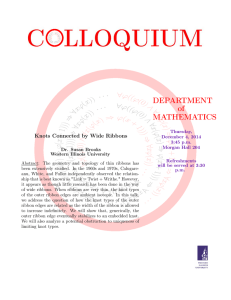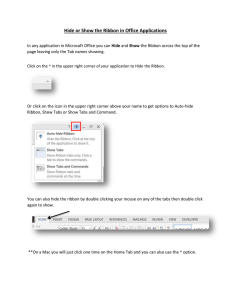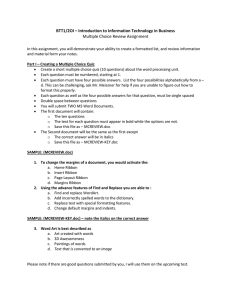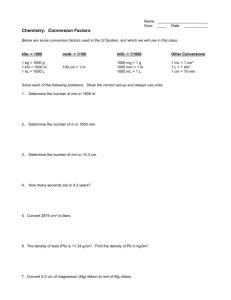Rolling Ribbons Please share
advertisement
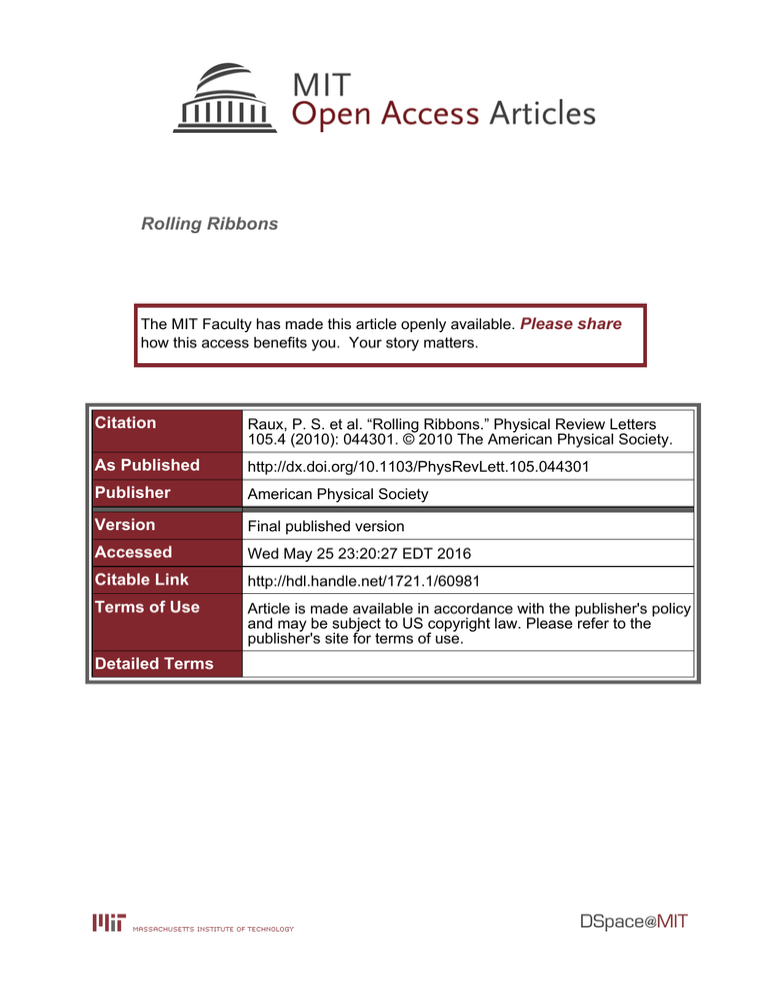
Rolling Ribbons The MIT Faculty has made this article openly available. Please share how this access benefits you. Your story matters. Citation Raux, P. S. et al. “Rolling Ribbons.” Physical Review Letters 105.4 (2010): 044301. © 2010 The American Physical Society. As Published http://dx.doi.org/10.1103/PhysRevLett.105.044301 Publisher American Physical Society Version Final published version Accessed Wed May 25 23:20:27 EDT 2016 Citable Link http://hdl.handle.net/1721.1/60981 Terms of Use Article is made available in accordance with the publisher's policy and may be subject to US copyright law. Please refer to the publisher's site for terms of use. Detailed Terms PRL 105, 044301 (2010) PHYSICAL REVIEW LETTERS week ending 23 JULY 2010 Rolling Ribbons P. S. Raux,1 P. M. Reis,1 J. W. M. Bush,1 and C. Clanet2 1 Department of Mathematics, Massachusetts Institute of Technology, Cambridge, Massachusetts 02139, USA 2 LadHyX, École Polytechnique, 91128 Palaiseau, France (Received 23 March 2010; published 23 July 2010) We present the results of a combined experimental and theoretical investigation of rolling elastic ribbons. Particular attention is given to characterizing the steady shapes that arise in static and dynamic rolling configurations. In both cases, above a critical value of the forcing (either gravitational or centrifugal), the ribbon assumes a two-lobed, peanut shape similar to that assumed by rolling droplets. Our theoretical model allows us to rationalize the observed shapes through consideration of the ribbon’s bending and stretching in response to the applied forcing. DOI: 10.1103/PhysRevLett.105.044301 PACS numbers: 46.70.De, 46.25.y, 46.35.+z Galileo’s study of rigid spheres rolling down an inclined ramp [1] is often considered as the starting point of modern physics, since it involves both theory and experiment [2,3]. The influence of ramp flexibility on the dynamics was recently considered by Aristoff et al. [4]. We here consider another variant of Galileo’s problem in which the ramp is rigid but the rolling body, an elastic cylindrical shell, is deformable. As will be shown, this dynamical elastic problem presents some common features with the rolling of a liquid drop on a hydrophobic surface [5–7] or a lubricated ramp [8]. We first present our experimental observations and then develop a supporting theoretical model. The ribbons are cast out of three different types of vinylpolysiloxane that produce three elastic polymers with Young’s moduli E ¼ 0:26 MPa, 0.56 MPa and 1.2 MPa, and respective densities ¼ 1050 kg=m3 , 1100 kg=m3 , and 1200 kg=m3 . The associated Poisson ratio is measured to be ¼ 0:5. The geometrical characteristics of the ribbons are radius R0 ¼ ð23:2 :4Þ mm, length L0 ¼ 2R0 , thickness ð0:8 < h0 < 3:25Þ mm, width ð18 < w0 < 28Þ mm, cross sectional area S0 ¼ 1 h0 w0 and momentum of inertia I0 ¼ 12 w0 h30 [Fig. 1(f)]. With this system, it is possible to vary the bending stiffness EI0 by a factor 400 (from 2 107 N m2 to 8 105 N m2 ) by adjusting the ribbon thickness h0 . Since the rolling ribbon stretches at high speeds, the stretched properties are denoted by R, L, h, w, S and I, respectively. To examine the rolling states, the ribbon is placed on the inner surface of a hollow, rotating stainless steel drum of radius Rdrum ¼ 150 mm, this drum being a practical alternative to Galileo’s ramp. Because of frictional forces between the polymer and stainless steel, there is no slippage between the drum and the ribbon, which is thus driven at a constant speed U prescribed by the drum. Typical steady, rolling shapes are presented in Figs. 1(a)–1(d). As the drum speed increases, the ribbon assumes progressively more distorted equilibrium shapes up to a critical speed at which periodic waves appear on its surface [Fig. 1(e)]. The critical ‘‘touchdown’’ speed is reached when the upper and the 0031-9007=10=105(4)=044301(4) lower ribbon surfaces come into contact. Since these surfaces move in opposite directions, their contact generally leads to complex time-dependent motions, for example, waves propagating in the opposite direction of rotation, ribbon bouncing, or even the sticking of the ribbon to the wall. Figure 1(g) presents the evolution of the observed ribbon shapes with increasing speed (blue denotes the static case, dark red the critical touchdown speed). Our goal now is to understand physically and describe theoretically the evolution of the shape with the rotation speed. Even in the absence of rotation, the ribbons may deform in response to gravity [Fig. 1(a)]. To quantify this static deformation with a single quantity, we introduce the aspect FIG. 1 (color online). A ribbon rolling at different speeds [or Froude number Fr ¼ U2 =ðgR0 Þ]: (a) Fr ¼ 0, (b) Fr ¼ 143, (c) Fr ¼ 236 (d) Fr ¼ 259, (e) An unsteady shape observed above the critical touchdown speed. (f) A schematic of the ribbon. (g) Experimentally observed dependence of ribbon shape on Froude number. Ribbon properties: E ¼ 0:26 MPa, ¼ 1050 kg=m3 , h ¼ 1:6 mm, w ¼ 27 mm. 044301-1 Ó 2010 The American Physical Society PRL 105, 044301 (2010) PHYSICAL REVIEW LETTERS H ratio ¼ 2R where H is the height at the middle of the 0 ribbon [Fig. 1(f)]. Note that ¼ 1 when the ribbon is undeformed, and ¼ Rh0 at touchdown. The balance between gravitational energy S0 R20 g and bending energy EI0 =R0 indicates a characteristic length scale Lg ¼ ðEI0 =gS0 Þ1=3 beyond which one expects substantial deformation. Small values of Lg =R0 will be associated with large ribbon deformations, large values with a circular shape. In Fig. 2, we present the evolution of the aspect ratio with g ¼ ðLg =R0 Þ3 . In the range g > 4, the circular shape is only weakly affected by gravity while strong deformations are observed for g 1. Touchdown is achieved at ?g ¼ 0:19. The observed dependence of static ribbon shape on g is rationalized in our subsequent theoretical developments. We observe that, as the speed increases, the rolling ribbon develops a two-lobed shape. A similar behavior has been reported for rotating liquid drops [7,9]. As the drop rotation speed increases, its shape evolves through a series of axisymmetric forms, from a sphere to an oblate ellipsoid to a torus. However, above a critical speed, the axisymmetric equilibrium shape is no longer adopted [10,11], and the drop assumes a two-lobed, peanut shape. The critical rotation speed L above which a drop of radius qffiffiffiffiffiffiffiffiffiffiffiffiffiffiffiffiffiffiffiffi RL loses its axisymmetry is found to scale as L =L R3L , where L and L are the surface tension and density, respectively. This scaling emerges from balancing the destabilizing rotational energy L R5L 2L with the stabilizing surface energy L R2L . Drawing an analogy between the liquid drop and our elastic ribbon suggests that the latter week ending 23 JULY 2010 will lose its axisymmetric form when its rotational energy S0 R30 2c greatly exceeds its elastic energy EI0 =R0 . Thus, even in the absence of the flattening influence of gravity, one anticipates deformed ribbons for velocities larger than pffiffiffiffiffiffiffiffiffi E=h0 =R0 . For the ribbon presented in Fig. 1, this critical velocity is of the order of 1 m=s, which is substantially less than that observed experimentally (Uc 7:5 m=s). This discrepancy has motivated the more precise analysis detailed below. Guided by the scaling analysis, we characterize the ribbon deformation in terms of the parameter i ¼ Eh2 =R20 U2 to study the ribbon deformation. We note that stretching is important in our experiments; thus, we define i in terms of h instead of h0 . The observed variation of with i is reported in Fig. 3. In the zero velocity limit (i ! 1), the aspect ratio tends towards the static value imposed by g . Since the results presented in Fig. 3 correspond to four different ribbons with four different values of g , we observe four different asymptotic values. We observe in Fig. 3 that the aspect ratio differs substantially from its static limit only for i 1. In the large velocity limit (i ! 0), the deformation increases ( ! 0) up until touchdown at ?i , the value of which depends on g . Typically, ?i 0:02. One way to show that ?i indeed depends on g is to consider the limit of a ribbon for which g ¼ ?g . In this limit, touchdown is achieved without any rotation, that is for U ¼ 0 or ?i ¼ 1. Apart from this H FIG. 3 (color online). Aspect ratio, ¼ 2R , of different roll0 2 ing ribbons as a function of the speed parameter i ¼ REh2 U2 . 0 H FIG. 2 (color online). Aspect ratio of static ribbons, ¼ 2R , 0 EI0 as a function of their normalized stiffness g ¼ gS R3 . The 0 0 line is deduced by integrating Eq. (7) with Fr ¼ 0. For the letters on the curve, we present in the inset the corresponding picture. The theoretical shape obtained through numerical integration of Eq. (7) is superposed as a thin white dashed line. Scale bars, 10 mm. Curves correspond to those predicted by Eq. (7). Circles, squares, diamonds, and triangles correspond to four different ribbons; specifically, g ¼ 0:278, 0.372, 0.429, 0.488. E ¼ 0:26 MPa for the first three ribbons and E ¼ 0:56 MPa for the last. Inset: Shape comparison for a single ribbon (R0 ¼ 22:8 mm, g ¼ 0:488, E ¼ 0:56 MPa) at different rotation speeds: (a) Cy ¼ 0:09, (b) Cy ¼ 0:16, (c) Cy ¼ 0:20, (d) Cy ¼ 0:25, where Cy ¼ U2 =E. Dashed curves are computed by integration of Eq. (7). Scale bar: 10 mm. 044301-2 PRL 105, 044301 (2010) PHYSICAL REVIEW LETTERS dependence of the critical velocity on the initial gravitational deformation of the ribbon, we observe that, qualitatively, the shape transition prompted by centripetal forces is similar to that caused by gravity and presented in Fig. 2. We proceed with a quantitative study, by developing a theoretical model that predicts the steady shapes of both static and rolling ribbons. A schematic diagram of the ribbon system is presented in Fig. 1(f). The ribbon shape is described in terms of the arc length s along its center line. Let n be the outward pointing unit vector normal to the ribbon, the angle between the local tangent vector t and the horizontal unit vector ex . Considering the ribbon as a slender elastic structure, the local force and torque balances can be expressed as [12]: F 0 ¼ K; (1) and FðsÞ ¼ week ending 23 JULY 2010 x Fx F js¼0 þ SU2 ½cosjs 1 ¼ : Fy gSs SU2 sinjs (4) Since the tension in the ribbon is equal to the tangential component of the internal force, we have F t ¼ 0Þ where ds ds0 is the extension of the ribbon. ES ðdsds ds0 Integrating this equation and combining it with (4) yields the increase of the ribbon’s free length: Z s Lf Lf0 ¼ Cy 1 cos þ sin ds0 : 1þ Fr Fr (5) Here, s ¼ Rs0 denotes the nondimensional curvilinear coordinate, and Lf0 the free length at rest. The Cauchy number 2 Cy ¼ U E indicates the relative magnitude of inertial and U2 stretching forces while the Froude number Fr ¼ gR ex0 F js¼0 is the presses that of inertia and gravity. Finally, ¼ gSR 0 ratio between the tension at rest and gravity. This tension depends on the natural curvature of the ribbon. Since our ribbons are molded, their natural curvature is close to 1=R0 and the tension is close to zero in the absence of gravity. In our numerical integration, we take this information into account by choosing the smallest possible value of . Since varies from 0 to 2 along the free length, the cosine and sine terms in (5) are much smaller than the constant after integration; thus, the stretching is uniform to leading order. In the contact zone, where there is no sliding, we extend the assumption of uniform stretching over the whole ribbon, so the total extended length L is given by x EI00 ¼ F n; (2) where F represents the internal forces and Kds the external ones. Primes denote derivatives with respect to s. To integrate this system, we divide the ribbon into two zones where the external constraints K are different: a contact zone and a free zone. In the free zone (Lf =2 < s < Lf =2, where Lf is the free length), there is no friction, but gravitational and centripetal forces act. In the contact zone (jsj > Lf =2), friction pins the ribbon to the drum. Consequently, the ribbon has a small but finite curvature prescribed by that of the drum: its center line is in transR lation at a constant speed UðRþ hÞ. L ¼ ð1 þ Cy ÞL0 : 2 In the free zone, the external force acting on an infinitesimal element of ribbon has both gravitational and centripetal contributions: K ¼ Sg þ SU2 0 n: (3) In order to determine boundary conditions for the vertical and horizontal components of the internal force, Fy and Fx respectively, we assume that the shape is symmetric with respect to the vertical midplane, an assumption consistent with experimental observations prior to touchdown of the ribbon. It is thus sufficient to consider one half of the ribbon. The symmetry also sets the boundary conditions at the top of the ribbon where the shape must be perpendicular to the axis of symmetry (js¼0 ¼ 0) and where there is no variation of curvature (00 js¼0 ¼ Fy js¼0 ¼ 0). We also assume continuity with the contact zone, which is insured by applying additional boundary conditions: a flat contact zone for the static case (js¼Lf =2 ¼ and 0 js¼Lf =2 ¼ 0) and a small curvature corresponding to that of the drum for the dynamic case (js¼Lf =2 ¼ xjs¼L 1 arcsinð Rdrumf Þ and 0 js¼Lf =2 ¼ Rdrum ). The internal force can be found by integrating (1) using (3), =2 (6) The variation of thickness due to transverse stretching is deduced from the Poisson ratio, ¼ 0:5: since our polymer conserves volume, the ribbon thickness, h ¼ h0 ð1 Cy Þ, necessarily decreases with increasing speed. In order to determine the shape of the free length, we substitute (4) into (2), which after nondimensionalization yields ð1 Cy Þ2 g 00 ¼ ðFr Þ sin s cos (7) EI0 again prescribes the relative magnitudes where g ¼ gS R3 0 0 of bending and gravity. We use a combined fourth and fifth order explicit Runge-Kutta method to integrate (7) numerically between s ¼ 0 and the first value of s that satisfies the condition s þ xjs ¼ L=2 where L is the stretched length given by (6). We use a shooting method, and close the system by adjusting the values of and 0 js¼0 to match the slope js¼Lf =2 and curvature 0 js¼Lf =2 of the substrate at the edge of the contact zone. We thus obtain the ribbon shape, ðsÞ, by integrating (7) with no fitting parameter. We first compare our model and experiments in the static (Fr ¼ 0) case. In Fig. 2, we present the shapes calculated 044301-3 PRL 105, 044301 (2010) PHYSICAL REVIEW LETTERS 1.35 case, the agreement between observed and predicted shapes is satisfactory. We have considered the rolling of elastic ribbons and shown that their shape results from a delicate coupling between rolling, bending, and stretching. While we have noted that the rolling ribbon has several features common with rolling droplets [6–8], a similar family of shapes has also been reported for tumbling blood cells [13], a tube collapsing under uniform pressure [14], and carbon nanotubes deformed by van der Waals forces [15,16]. The rationale for similar shape progressions emerging in these disparate physical systems has yet to be carefully considered, but should be informed by our study. Elongation, L/L0 1.3 1.25 1.2 1.15 Γg=.278, E=.26MPa Γg=.372, E=.26MPa Γg=.429, E=.26MPa Γg=.488, E=.56MPa Eqn. (6) 1.1 1.05 1 0 0.1 0.2 0.3 week ending 23 JULY 2010 0.4 Cauchy number, Cy FIG. 4 (color online). Ribbon elongation as a function of the 2 Cauchy number Cy ¼ U E . The black line is the dependence predicted by Eq. (6). Different symbols correspond to different values of normalized stiffness g . Characteristic error bars are shown for only one set of experiments. from (7) and see good agreement between theory and experiment for the four different ribbons considered. We proceed by verifying our assumption of constant stretching along the rolling ribbon. In Fig. 4, we present the dependence of length extension, LL0 , on the Cauchy number for four different ribbons. Despite the uncertainty in ribbon length introduced by the image analysis, a linear fit of the experimental results gives a slope close to that predicted by (6) within a 6% margin of error. The observed stretching is thus consistent with our hypothesis of uniform extension. For rolling ribbons, the curves in Fig. 3 represent the prediction obtained by integrating (7) for the values of g corresponding to the observed deformation at rest, that is, the asymptotic value of at large i . The discrepancies observed near the critical touchdown speed are likely due to the climbing of the ribbon along the inner wall of the rotating cylinder, and the resulting fore-aft asymmetry of the ribbon. In the dynamic case, we also compare observed and predicted ribbon shapes, as presented in the inset of Fig. 3 for four different values of Cy on the same ribbon, which necessarily has a single g value. As in the static [1] G. Galilei, Dialogues Concerning Two New Sciences (Dover Publications Inc., New York, NY., 1954). [2] H. F. Cohen, The Scientific Revolution: A Historiographical Inquiry (The University of Chicago Press, Chicago, USA, 1994). [3] S. Drake, N. M. Swerdlow, and T. H. Levere, Essays On Galileo And The History And Philosophy Of Science (University of Toronto Press, Toronto, Canada, 1999). [4] J. M. Aristoff, C. Clanet, and J. W. M. Bush, Proc. R. Soc. A 465, 2293 (2009). [5] L. Mahadevan and Y. Pomeau, Phys. Fluids 11, 2449 (1999). [6] P. Aussillous and D. Quéré, Nature (London) 411, 924 (2001). [7] P. Aussillous and D. Quéré, J. Fluid Mech. 512, 133 (2004). [8] S. R. Hodges, O. E. Jensen, and J. M. Rallison, J. Fluid Mech. 512, 95 (2004). [9] L. Elkins, P. Ausillous, J. Bico, D. Quere, and J. W. M. Bush, Meteorit. Planet. Sci. 38, 1331 (2003). [10] R. A. Brown and L. E. Scriven, Proc. R. Soc. A 371, 331 (1980). [11] Lord Rayleigh, Philos. Mag. 28, 161 (1914). [12] L. D. Landau and E. M. Lifshitz, Theory Of Elasticity, Course of Theoretical Physics, Vol. 7 (Pergamon Press, Oxford, 1986). [13] J. M. Skotheim and T. W. Secomb, Phys. Rev. Lett. 98, 078301 (2007). [14] J. E. Flaherty, J. B. Keller, and S. I. Rubinow, SIAM J. Appl. Math. 23, 446 (1972). [15] T. Hertel, R. E. Walkup, and P. Avouris, Phys. Rev. B 58, 13 870 (1998). [16] A. Pantano, D. M. Parks, and M. C. Boyce, J. Mech. Phys. Solids 52, 789 (2004). 044301-4

